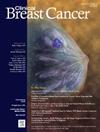De-Escalating the Extent of Sentinel Lymph Node Biopsy in Patients With Ductal Carcinoma in Situ Undergoing Mastectomy
IF 2.9
3区 医学
Q2 ONCOLOGY
引用次数: 0
Abstract
Sentinel lymph node biopsy (SLNB) for axillary staging in patients with ductal carcinoma in situ (DCIS) undergoing mastectomy is debated due to low nodal positivity rate and risk of morbidity. Standard SLNB entails removing all lymph nodes (LN) that have a radioactive count > 10% of the most radioactive node, contain blue dye or are palpably suspicious. In this study, we hypothesize that judicious SLNB with attempt to remove only the node with the highest radioactive count provides sufficient pathologic information while minimizing morbidity. A single institution prospective database was retrospectively reviewed to identify women with DCIS who underwent mastectomy and SLNB between 2010 and 2022. Patient characteristics, number of SLNs retrieved, pathologic results and long-term upper extremity complications were analyzed. A total of 743 LNs were removed in 324 pts. Median (IQR) age was 62 (51-70) years. Dual tracer technique, with technetium-99m labeled radiocolloid and blue dye, was used in 311 (96%) pts, whereas single agent (radioisotope or blue dye alone) was utilized in 9 (2.8%) and 4 (1.2%) patients, respectively. Median (IQR) number of SLN removed was 2 (1-3) (range 1-9). In 99% of cases, the SLN with the highest radioactive count was identified among the first 3 dissected LNs. Final pathology revealed upstaging to invasive cancer in 27.5% ( = 89) of the breasts and nodal positivity in 1.9% ( = 6) of the patients. In all 6 cases, metastatic disease was identified in the LN with highest radioactive count among the LNs retrieved. No additional metastatic nodes were identified after > 3 SLN had been removed. At median follow-up of 57 (range 28-87) months, 8.3% ( = 27) of pts complained of long-term upper extremity symptoms. 7.1% (23 pts) were referred to physical therapy for symptoms such as swelling, fullness, heaviness, stiffness, or sensory discomfort in the upper extremity and/or axillary cording. Long-term upper extremity complications were higher when > 3 SLNs compared to ≤ 3 SLNs were removed (10.4% vs. 6.5%, = .005). In this cohort of patients with DCIS undergoing mastectomy who were upstaged on final pathology to node positive invasive cancers, the SLN with the highest radioactive count provided sufficient information for axillary staging. Acknowledging that the “hottest” LN is not always the first 1 removed, these data support an increased likelihood of developing long-term complications when more than 3 SLNs are removed. Rather than comprehensive removal of all SLNs meeting the standard “10% rule,” prioritizing the sequence of removal to the highest count provides the same prognostic information with reduced morbidity.缩小乳腺切除术原位乳管癌患者前哨淋巴结活检的范围
对接受乳房切除术的乳腺导管原位癌(DCIS)患者进行前哨淋巴结活检(SLNB)以进行腋窝分期,由于结节阳性率低和发病风险高而备受争议。标准的 SLNB 需要切除所有放射性计数大于放射性最强结节的 10%、含有蓝色染料或明显可疑的淋巴结(LN)。在本研究中,我们推测明智的 SLNB 只切除放射性计数最高的淋巴结,这样既能提供足够的病理信息,又能将发病率降至最低。我们对单个机构的前瞻性数据库进行了回顾性审查,以确定在 2010 年至 2022 年间接受乳房切除术和 SLNB 的 DCIS 女性患者。分析了患者特征、取出的 SLN 数量、病理结果和长期上肢并发症。324名患者共切除了743个LN。中位(IQR)年龄为 62(51-70)岁。311例(96%)患者采用了锝-99m标记放射性胶体和蓝色染料的双示踪技术,而分别有9例(2.8%)和4例(1.2%)患者采用了单剂(放射性同位素或蓝色染料)技术。切除的 SLN 数量中位数(IQR)为 2(1-3)(范围 1-9)。在 99% 的病例中,放射性计数最高的 SLN 是在前 3 个切除的 LN 中确定的。最终病理结果显示,27.5%(=89 例)的乳房上移至浸润癌,1.9%(=6 例)的患者结节阳性。在所有 6 个病例中,均在取回的 LN 中发现了放射性计数最高的 LN 转移性疾病。在切除 3 个以上 SLN 后,没有发现其他转移性结节。中位随访时间为 57 个月(28-87 个月),8.3% 的患者(= 27 例)抱怨长期出现上肢症状。7.1%的患者(23例)因上肢肿胀、饱胀、沉重、僵硬或感觉不适和/或腋窝绞痛等症状而接受物理治疗。与切除≤3个SLN相比,切除>3个SLN时的上肢长期并发症更高(10.4% vs. 6.5%,= .005)。在这组接受乳房切除术的 DCIS 患者中,最终病理分期为结节阳性的浸润性癌,放射性计数最高的 SLN 为腋窝分期提供了足够的信息。虽然 "最热 "的 LN 并不总是第一个被切除的 LN,但这些数据表明,如果切除的 SLN 超过 3 个,出现长期并发症的可能性就会增加。与全面切除所有符合标准 "10% 规则 "的 SLN 相比,优先切除数量最多的 SLN 既能提供相同的预后信息,又能降低发病率。
本文章由计算机程序翻译,如有差异,请以英文原文为准。
求助全文
约1分钟内获得全文
求助全文
来源期刊

Clinical breast cancer
医学-肿瘤学
CiteScore
5.40
自引率
3.20%
发文量
174
审稿时长
48 days
期刊介绍:
Clinical Breast Cancer is a peer-reviewed bimonthly journal that publishes original articles describing various aspects of clinical and translational research of breast cancer. Clinical Breast Cancer is devoted to articles on detection, diagnosis, prevention, and treatment of breast cancer. The main emphasis is on recent scientific developments in all areas related to breast cancer. Specific areas of interest include clinical research reports from various therapeutic modalities, cancer genetics, drug sensitivity and resistance, novel imaging, tumor genomics, biomarkers, and chemoprevention strategies.
文献相关原料
| 公司名称 | 产品信息 | 采购帮参考价格 |
|---|
 求助内容:
求助内容: 应助结果提醒方式:
应助结果提醒方式:


